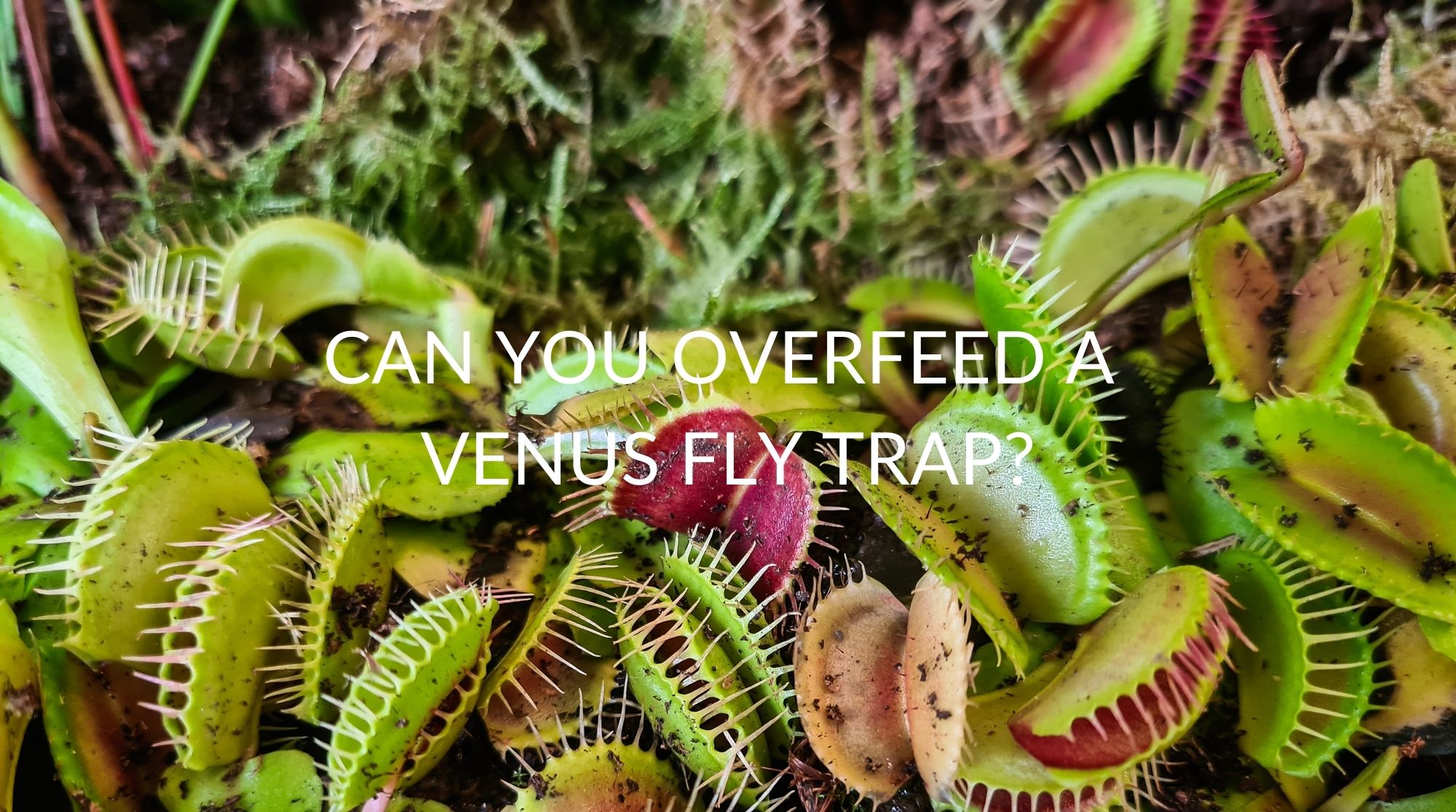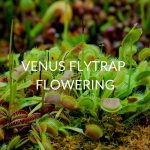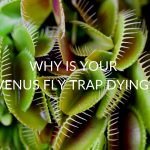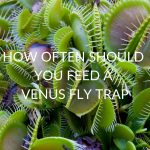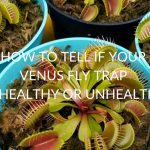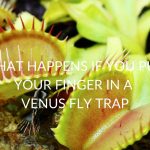The Venus flytrap has a particular diet that they like; small bugs. When their traps are open, they could potentially catch their own food. This is because their traps emit a sweet aroma that lures critters in. Once they are in, the small trigger hairs within a trap will notice a bug moving around and will start to close.
Afterwards, they do a little happy dance while they break down and digest the bug. It’s quite a fascinating process to watch. Those who have these plants indoors and feed them bugs might be asking; can you overfeed a Venus flytrap?
It’s very difficult to overfeed one of these plants, but it’s not impossible. You can watch out for signs that your plant is having trouble breaking down all the food they have received, and be sure that when you do feed them, you feed them the right things. Knowing how often to feed a Venus flytrap is also ideal to ensure its sustainability.
Can You Overfeed A Venus Fly Trap?
Not all Venus flytrap experts agree on if you can overfeed a Venus flytrap. This is partially due to Venus fly traps’ nature. They take some time to break down their food, and they won’t open back up until they are done, and all that’s left is a carcass. You also don’t have to feed every trap at once, as they share the nutrients.
You can overfeed them with a bug that is too big to break down. The bug you feed them should be one-third the size of a trap. When traps are babies, you won’t need to feed them. If they are getting adequate sunlight and distilled water, they will be okay. A bug that’s too big won’t break down fully and will potentially lead to rotting.
You can end up overfeeding your Venus flytrap if you feed them multiple bugs at once. You don’t need to give food to all of the traps at the same time. Feeding one is more than enough. If too many traps are trying to break down bugs simultaneously, they won’t have enough energy to expend to digest them all, which could lead to rot as well.
It’s best to err on the side of caution, given the Venus fly trap’s ability to store nutrients so well. Thus, it’s better to underfeed them than overfeed them, though really, you should be aiming for feeding them appropriately. However, they are better off eating less than eating more.
What Happens If You Feed A Venus Fly Trap Too Much?
This intelligent plant will most likely try to break down all the food that is fed to them. They are quite smart plants. Because of the way they break down their food through enzymes, however, the process is slow. If a bug is in their trap for too long, it can start to rot, which will cause the trap to rot.
When a Venus flytrap catches or is given bugs, the trigger hairs alert them to prey, and they will begin their process of closing. They have glands within their traps that will help them break down the bug for digestion. However, they can only process the softer parts of the bug, which is why when they open back up, you’ll usually find parts of the bug left.
Each individual trap can only open and close so many times in its lifespan. This is why traps often die off, and new ones regrow. Overfeeding your Venus flytrap can cause those traps to die prematurely, given that they have wasted all the energy they’ve had eating more than they’ve needed to in order to survive.
One thing to keep in mind if you’re feeding a plant indoors is that some of the nutrients they consume through bugs will seep into their soil over time. This could cause mineral buildup, which will slowly kill your Venus flytrap. You should repot them before winter dormancy with a new container and some peat moss.
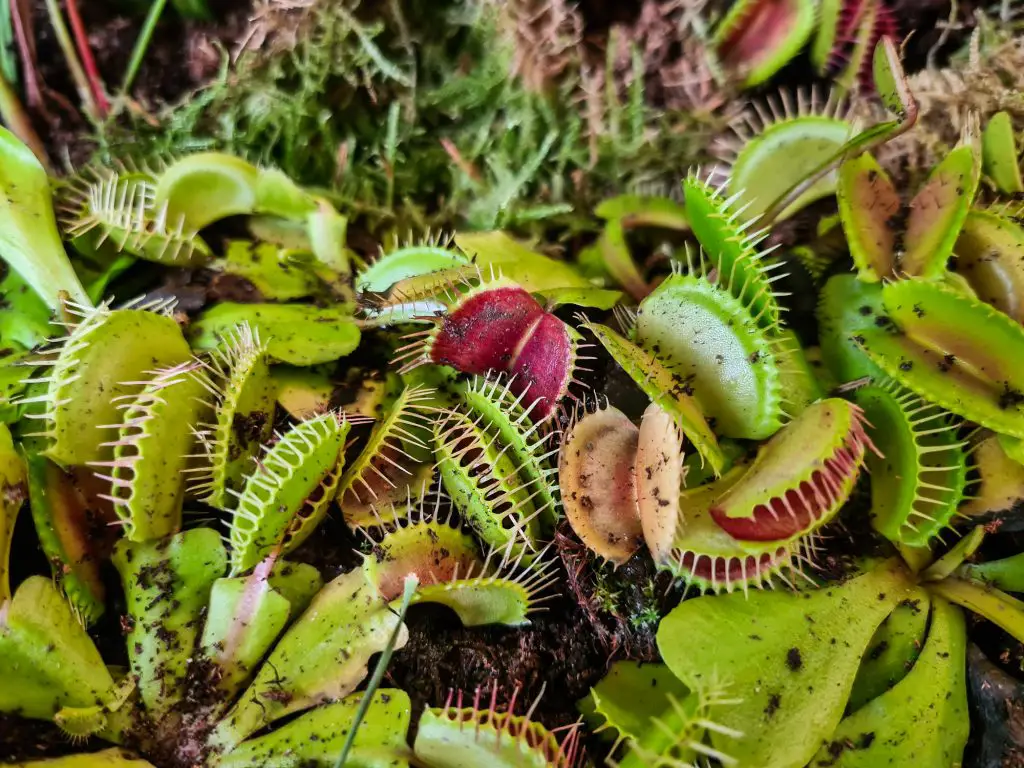
How Often Should I Feed My Venus Fly Trap?
The best practice is to feed one trap just one insect every two to four weeks. If one trap were to get one bug once a month, that would be adequate nutrition as well. It takes a trap anywhere from a week to two weeks to digest their bug, so feeding all the traps all at once would be way too overwhelming for the plant to break down.
You may be concerned when so many traps are open and might assume you should feed all of them. You don’t need to worry that they are hungry; they share food, so they are perfectly okay staying open. If you have a larger Venus flytrap, you can consider feeding two traps in one feeding to ensure that they have enough nutrients to spread throughout the entire plant.
Speaking of open traps, you should not try to make the traps close when you are not feeding them. Some plant owners will get carried away, stimulating the traps to close because it is so fascinating to watch the process. However, you’re making your plant waste too much energy, which could lead to them having a hard time breaking down actual food in the future.
Wondering whether Venus Flytraps close at night?
You can refrain from feeding your Venus flytrap in winter. At this time, they essentially hibernate. These plants go through their own process of storing energy in order to grow and gain strength. Even with proper feeding, you’ll also notice that some traps will die. That’s completely normal, and new ones will grow in their place.
What Should I Feed My Venus Fly Trap?
While Venus flytraps are called carnivorous plants, it’s a misconception that they can eat any type of meat. The only thing a Venus flytrap should be eating is small bugs. The bugs can be dead or alive or rehydrated, but if the bug is not alive, you have to do some extra work to help the traps close.
Some of the bugs that Venus flytraps enjoy include flies, spiders, crickets, bloodworms, mealworms, and some beetles. While they can technically eat ants, some are too small for them to notice in their trap, and there is also some evidence that ants may contain a chemical that is toxic to a Venus flytrap. Aphids are also too small for traps to digest.
You should also be wary of caterpillars and stronger beetles, as they can end up eating their way out of a trap before the trap has a chance to start breaking them down. This process can end up killing the trap. Small grasshoppers or baby grasshoppers can work too, but if they are too big, they can escape before the trap can close all the way.
It is not recommended to feed your Venus flytrap fish food, even though many will opt for this route because it often consists of mealworms or bloodworms. However, some fish food contains additives that are bad for your plant. Other pet foods and human food of any kind are also not good to feed your traps.
How Long Can A Venus Fly Trap Go Without Food?
Technically speaking, you don’t ever have to feed a Venus flytrap anything, and they will survive. However, they won’t thrive as well as they could if they were fed. They’ll catch enough food to sustain themselves if they are outdoors, and you won’t have to feed them yourself. Indoors, chances are they can’t catch enough bugs to be sufficient.
Since Venus flytraps don’t live in fertilizer, the only way to get adequate nutrients to sustain a long and happy life is through eating insects. Like most plants, they can feed off of sunlight through photosynthesis. However, they have adapted to eating bugs in their native land in order to gain the nutrients they cannot get from proper soil.
When the Venus flytrap is in its dormant phase in winter, you don’t need to be concerned about them going through the winter months without food. You should be making sure their conditions are proper, however, to simulate winter dormancy. This might include altering the temperature of the room they are in and slowly reducing the amount of light they get.
During this dormancy period, the plant will have enough nutrients within their roots and plants to keep themselves alive when they are not feeding. If you are feeding them enough throughout the rest of the seasons, you don’t have to be concerned. It is natural that some traps might die, but new ones will grow back.
Frequently Asked Questions
Knowing how to feed your Venus flytrap adequately comes with a little bit of trial and error, but thankfully, there is a lot of information out there to ease your concerns, so you keep your Venus flytrap happy and healthy.
How Do You Feed A Venus Fly Trap Dead Bugs?
If you don’t feel comfortable handling live bugs, dead bugs can do the trick. You can also opt for blood worms or mealworms that you can rehydrate and even crush into a fine powder if you’re more comfortable.
With dead bugs, you will have to place them into a trap with tweezers or a toothpick and massage it gently into the trigger hairs. This will alert the trap that there is food inside, and they will start to close. Once they are almost closed, you can very gently squeeze the trap together with two fingers to encourage it to close completely.
Do Venus Fly Traps Dance When They Ecebat?
Many people will compare the way a Venus flytrap moves when it is breaking down their food as dancing. It’s quite thrilling to watch, given that most plants don’t have the ability to make themselves move.
Why Is My Venus Fly Trap Turning Black?
When a trap is dying, it will start to turn black. This might also be a sign that that particular trap is starting to rot because the food you gave them was too big. You can simply cut that trap off when it turns black. It shouldn’t impact the health of the rest of your plant unless it stays attached for too long.
How Big Can A Venus Fly Trap Get?
The absolute biggest Venus flytrap according to Guinness World Records, had traps that were 2.4 inches long. Typically, the Venus flytrap plant itself will grow to be about five to six inches, with traps that are usually about one to 1.5 inches in length.
Why Do Venus Fly Traps Need Distilled Water?
Distilled water or rainwater are the only two types of water that a Venus flytrap can handle. Any other type of water has minerals that a Venus flytrap cannot absorb. Watering adequately is very important; if the soil is dry and crumbly, the plant needs more water.
Recap
Feeding Venus fly traps small bugs is not necessary for them to survive, but you’ll be giving your plant the best possible chance of thriving and living a long life. When taken care of properly, a Venus flytrap can live for up to 20 years.
It’s good to know about the type of care a Venus flytrap needs before making the commitment. They are unlike other plants in so many ways, which is part of their appeal as well as a drawback to some. It requires a little bit more effort to keep a Venus flytrap alive, but it can be a rewarding process when you watch the beautiful plant bloom.
It’s difficult, but it is possible to overfeed a Venus flytrap. You can end up giving it too much food to break down at once or food that is too big for them to break down. Given that they can still survive without eating bugs, your best bet is to space out the feedings until you can determine what your particular plant needs.

